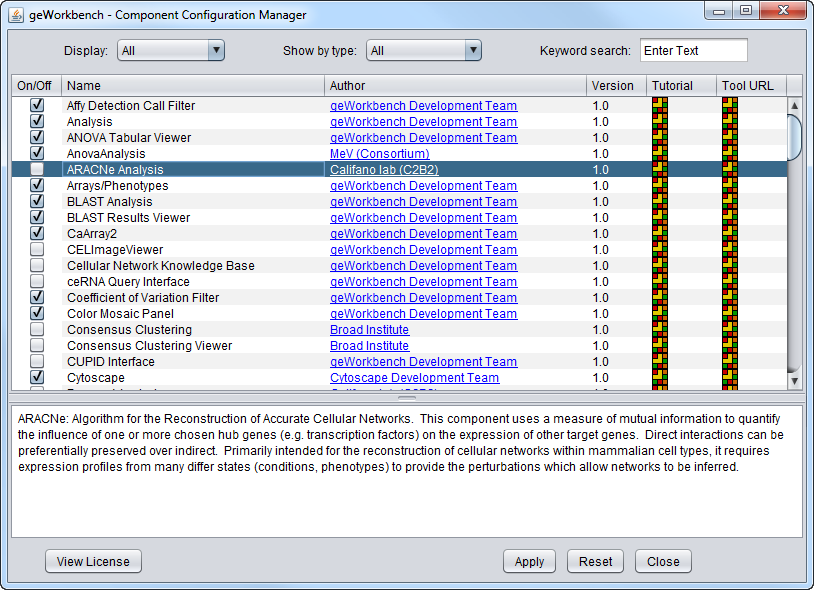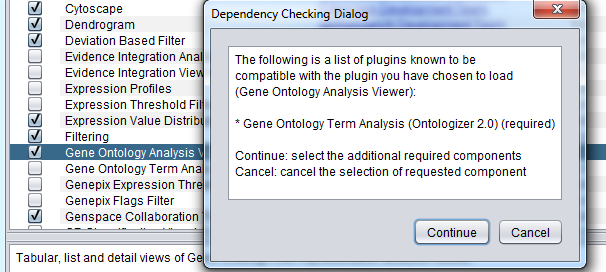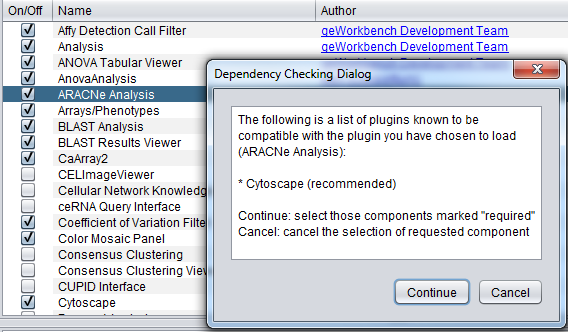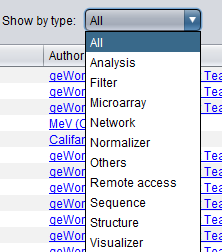Difference between revisions of "Component Configuration Manager"
(→Component Dependencies) |
(→Component Dependencies) |
||
| Line 29: | Line 29: | ||
* '''Recommended''' - If component B is recommended for use with component A, then if A is selected, the user will be notified that B is recommended. However, component B will not be automatically selected for addition when component A is loaded. The user must select B manually. | * '''Recommended''' - If component B is recommended for use with component A, then if A is selected, the user will be notified that B is recommended. However, component B will not be automatically selected for addition when component A is loaded. The user must select B manually. | ||
| − | An example is shown in the following figure, where adding the Gene Ontology Analysis component also requires adding the Gene Ontology Viewer component. | + | An example of a required relationship is shown in the following figure, where adding the Gene Ontology Analysis component also requires adding the Gene Ontology Viewer component. |
[[Image:CCM_adding_GO_dependency_check.png]] | [[Image:CCM_adding_GO_dependency_check.png]] | ||
| Line 43: | Line 43: | ||
If a component requires agreeing to a license, the license will also be displayed at this time, with the option to accept or reject it. | If a component requires agreeing to a license, the license will also be displayed at this time, with the option to accept or reject it. | ||
| + | |||
| + | An example of a recommended relationship, between ARACNe and Cytoscape, is illustrated below. | ||
| + | |||
| + | |||
| + | [[Image:CCM_Recommended_relationship.png]] | ||
==Framework Component Dependencies== | ==Framework Component Dependencies== | ||
Revision as of 17:48, 23 September 2011
|
Home | Quick Start | Basics | Menu Bar | Preferences | Component Configuration Manager | Workspace | Information Panel | Local Data Files | File Formats | caArray | Array Sets | Marker Sets | Microarray Dataset Viewers | Filtering | Normalization | Tutorial Data | geWorkbench-web Tutorials |
Analysis Framework | ANOVA | ARACNe | BLAST | Cellular Networks KnowledgeBase | CeRNA/Hermes Query | Classification (KNN, WV) | Color Mosaic | Consensus Clustering | Cytoscape | Cupid | DeMAND | Expression Value Distribution | Fold-Change | Gene Ontology Term Analysis | Gene Ontology Viewer | GenomeSpace | genSpace | Grid Services | GSEA | Hierarchical Clustering | IDEA | Jmol | K-Means Clustering | LINCS Query | Marker Annotations | MarkUs | Master Regulator Analysis | (MRA-FET Method) | (MRA-MARINa Method) | MatrixREDUCE | MINDy | Pattern Discovery | PCA | Promoter Analysis | Pudge | SAM | Sequence Retriever | SkyBase | SkyLine | SOM | SVM | T-Test | Viper Analysis | Volcano Plot |
Contents
Overview
geWorkbench supports the dynamic loading and unloading of individual components for analysis and visualization. The Component Configuartion Manager (CCM) lists each available component, provides descriptive and license information, and controls loading and unloading. The ability to customize the loaded components may be useful to those who intend only to use particular types of analysis. It may in some cases also increase the responsiveness of the application, as potentially fewer viewer components may need to respond to particular data events (new data set, marker set activation etc.).
In brief, components can be loaded by checking the box adjacent to their entry in the list, and hitting Apply. Components can be unloaded in the same way, by unchecking their box and applying the change.
As shipped, the CCM may appear as in the figure below, with only basic components configured. Individual components can be added by clicking on their check boxes.
Available Component List
The list of components includes the following column headings:
- On/Off - checking will select the component for loading. Unchecking the box will lead to the component being unloaded.
- Name: Component name
- Author - Component author or source of primary calculation code.
- Version - Component version
- Tutorial - Link to web-based tutorial/manual if available.
- Tool URL - Link to tool home page if available.
Component Dependencies
geWorkbench tracks component dependencies, for example between an analysis component and its viewer. These dependencies are all handled in the CCM.
There are two types of dependency:
- Required - If component A requires component B, then if A is selected for loading in the CCM, B will also be selected. The relationship is reciprocal - if A requires B, then B requires A.
- Recommended - If component B is recommended for use with component A, then if A is selected, the user will be notified that B is recommended. However, component B will not be automatically selected for addition when component A is loaded. The user must select B manually.
An example of a required relationship is shown in the following figure, where adding the Gene Ontology Analysis component also requires adding the Gene Ontology Viewer component.
After clicking "Proceed", all needed components are selected to be added.
If a component requires agreeing to a license, the license will also be displayed at this time, with the option to accept or reject it.
An example of a recommended relationship, between ARACNe and Cytoscape, is illustrated below.
Framework Component Dependencies
The Filtering and Normalization framework components have been made dependent on all filter and normalization method components, respectively. Thus these framework components can only be removed if first all filters or normalizers are removed in the CCM.
Controlling display of components
Display
Displayed components can be limited by the following menu choices:
- All
- Only Loaded
- Only Unloaded
Show by type
In addition, a pulldown menu allows only particular categories of components to be viewed:
- Analysis
- Filters
- Normalizers
- Visualizers
- Others - any components that fall in none of the above categories.
Keyword Search
The list of components can be searched by typing in a word here. Displayed choices will be progressively narrowed as typing occurs.
Controls
Once the desired changes to the list of components has been made, the changes are put into effect by pushing the Apply button.
- Apply - if any changes have been made to the check-boxes indicating which components are to be loaded, pushing "Apply" causes the changes to actually be be made.
- Reset - If changes have been made but "Apply" has not been pushed, set all checkboxes back to their previous state.
- Close - Close the CCM window.
- View license - If a license is required for a component, it can be displayed by highlighting the component in the list and pressing this button.




